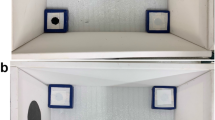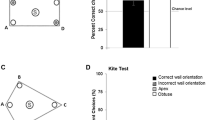Abstract
Since Cheng (Cognition 23:149–178, 1986) first proposed the “geometric module” in rats, a great deal of research has focused on how other species use geometric information and how geometric encoding may differ across species. Here, hand-reared and wild-caught black-capped chickadees and wild-caught mountain chickadees searched for food hidden in one corner in a rectangular environment. Previous research has shown that mountain chickadees do not spontaneously encode geometric information when a salient feature is present near the goal location. Using a slightly different training and testing procedure, we found that both hand-reared and wild-caught black-capped chickadees encoded geometric information, even in the presence of a salient landmark. Some, but not all, mountain chickadees also encoded geometric information. Overall, our results suggest that use of geometric information may be a less preferred strategy for mountain chickadees than for either wild-caught or hand-reared black-capped chickadees. To our knowledge, this is the first direct interspecies comparison of use of geometric information in a spatial orientation task.



Similar content being viewed by others
References
Brown AA, Spetch ML, Hurd PL (2007) Growing in circles: rearing environment alters spatial navigation in fish. Psychol Sci 18:569–573
Cheng K (1986) A purely geometric module in the rat’s spatial representation. Cognition 23:149–178
Cheng K, Newcombe NS (2005) Is there a geometric module for spatial orientation? Squaring theory and evidence. Psychon B Rev 12:1–23
Chiandetti C, Vallortigara G (2008a) Is there an innate geometric module? Effects of experience with angular geometric cues on spatial reorientation based on the shape of the environment. Anim Cogn 11:139–146
Chiandetti C, Vallortigara G (2008b) Spatial reorientation in large and small enclosures: comparative and developmental perspectives. Cogn Process 9:229–238
Chiandetti C, Regolin L, Sovrano VA, Vallortigara G (2007) Spatial reorientation: the effects of space size on the encoding of landmark and geometry information. Anim Cogn 10:159–168
Gallistel CK (1990) The organization of learning. MIT Press, Cambridge
Gouteux S, Thinus-Blanc C, Vauclair J (2001) Rhesus monkeys use geometric and nongeometric information during a reorientation task. J Exp Psychol Gen 130:505–519
Gray ER, Bloomfield LL, Ferrey A, Spetch ML, Sturdy CB (2005) Spatial encoding in mountain chickadees: features overshadow geometry. Biol Lett 1:314–317
Griffiths R, Double MC (1998) A DNA test to sex most birds. Mol Ecol 7:1071–1075
Hermer L, Spelke ES (1994) A geometric process for spatial representation in young children. Nature 370:57–59
Hermer L, Spelke E (1996) Modularity and development: the case of spatial reorientation. Cognition 61:195–232
Hill BG, Lein MR (1988) Ecological relations of sympatric Black-capped and Mountain Chickadees in southwestern Alberta. Condor 90:875–884
Kelly DM, Spetch ML, Heth CD (1998) Pigeon’s encoding of geometric and featural properties of a spatial environment. J Comp Psychol 112:259–269
Learmonth AE, Nadel L, Newcombe NS (2002) Children’s use of landmarks: Implications for modularity theory. Psychol Sci 13:337–341
Lourenco SF, Huttenlocher J (2006) How do young children determine location? Evidence from disorientation tasks. Cognition 100:511–529
Lourenco SF, Huttenlocher J (2007) Using geometry to specify location: implications for spatial coding in children and non-human animals. Psychol Res 71:252–264
Pravosudov VV, Clayton NS (2002) A test of the adaptive specialization hypothesis: population differences in caching, memory, and the hippocampus in black-capped chickadees (Poecile atricapilla). Behav Neurosci 116:515–522
Sokal RR, Rohlf FJ (1995) Biometry: the principles and practices of statistics in biological research. W. H. Freeman, New York
Sovrano VA, Bisazza A, Vallortigara G (2002) Modularity and spatial reorientation in a simple mind: encoding of geometric and nongeometric properties of a spatial environment by fish. Cognition 85:B51–B59
Sovrano VA, Bisazza A, Vallortigara G (2003) Modularity as a fish (Xenotoca eiseni) views it: conjoining geometric and nongeometric information for spatial reorientation. J Exp Psychol Anim B 29:199–210
Sovrano VA, Bisazza A, Vallortigara G (2005) Animals’ use of landmarks and metric information to reorient: effect of the size of the experimental space. Cognition 97:121–133
Sovrano VA, Bisazza A, Vallortigara G (2007) How fish do geometry in large and in small spaces. Anim Cogn 10:47–54
Tommasi L, Vallortigara G (2004) Hemispheric processing of landmark and geometric information in male and female domestic chicks (Gallus gallus). Behav Brain Res 155:85–96
Tommasi L, Andrew RJ, Vallortigara G (2000) Eye use in search is determined by the nature of the task in the domestic chick (Gallus gallus). Behav Brain Res 112:119–126
Vallortigara G, Zanforlin M, Pasti G (1990) Geometric modules in animals’ spatial representations: a test with chicks (Gallus gallus domesticus). J Comp Psychol 104:248–254
Vallortigara G, Feruglio M, Sovrano VA (2005) Reorientation by geometric and landmark information in environments of different size. Dev Sci 8:393–401
Vargas JP, López JC, Salas C, Thinus-Blanc C (2004) Encoding of geometric and featural information by goldfish (Carassius auratus). J Comp Psychol 118:206–216
Wystrach A, Beugnon G (2009) Ants learn geometry and features. Curr Biol 19:61–66
Acknowledgments
This research was supported by a Natural Sciences and Engineering Research Council of Canada Discovery Grant (NSERC), Alberta Ingenuity Fund (AIF) New Faculty Grant, Canada Foundation for Innovation (CFI) New Opportunities Grant along with start-up funding and CFI partner funding from the University of Alberta, Edmonton, Alberta, Canada to CBS, a Natural Sciences and Engineering Research Council of Canada Discovery Grant awarded to MLS, a Natural Science and Engineering Research Council of Canada postgraduate scholarship awarded to ERB and an Alberta Ingenuity Studentship to LLB. All animal studies were conducted in accordance with the Canadian Council on Animal Care Guidelines and Policies with approval from the Biosciences Animal Policy and Welfare Committee for the University of Alberta. The authors wish to thank Rabail Chaudhry, Wu Cheuk Sun, Nathan Dahl, Kelly Gordon, Lindsay Hoban and Kirsten Williams for their help running subjects and scoring data, as well as Isaac Lank for help with the apparatus and technical assistance.
Author information
Authors and Affiliations
Corresponding author
Rights and permissions
About this article
Cite this article
Batty, E.R., Bloomfield, L.L., Spetch, M.L. et al. Comparing black-capped (Poecile atricapillus) and mountain chickadees (Poecile gambeli): use of geometric and featural information in a spatial orientation task. Anim Cogn 12, 633–641 (2009). https://doi.org/10.1007/s10071-009-0222-3
Received:
Revised:
Accepted:
Published:
Issue Date:
DOI: https://doi.org/10.1007/s10071-009-0222-3




